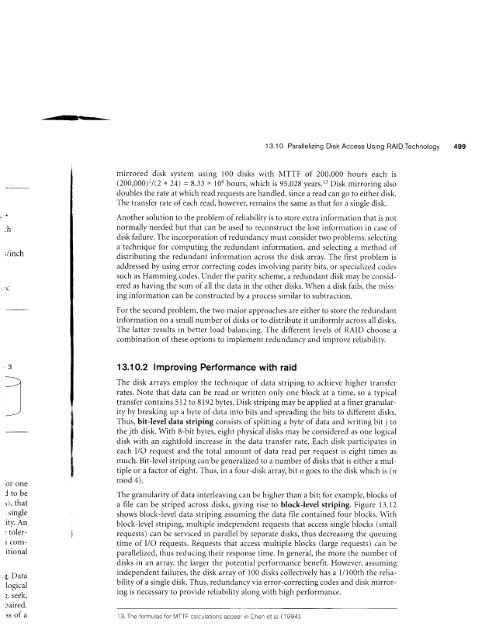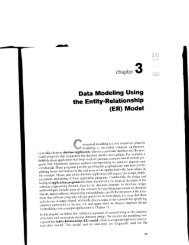13.1 through 13.5, 13.10 and 13.11
13.1 through 13.5, 13.10 and 13.11
13.1 through 13.5, 13.10 and 13.11
You also want an ePaper? Increase the reach of your titles
YUMPU automatically turns print PDFs into web optimized ePapers that Google loves.
13. 10 Parallelizing Disk Access Using RAID Technology499mirrored disk system using 100 disks with MTTF of 200,000 hours each is(200,000)r/(2 x 24) = 8.33 * 108 hours, which is 95,028 years.rs Disk mirroring alsodoubles the rate at which read requests are h<strong>and</strong>led, since a read can go to either disk.The transfer rate of each read, however, remains the same as that for a single disk.:h;/inchAnother solution to the problem of reiiability is to store extra information that is notnormally needed but that can be used to reconstruct the lost information in case ofdisk failure. The incorporation of redundancy must consider two problems: selectinga technique for computing the redundant information, <strong>and</strong> selecting a method ofdistributing the redundant information across the disk array. The first problen-r isaddressed by using error correcting codes involving parity bits, or specialized codessuch as Hamming codes. Under the parity scheme, a redundant disk may be consideredas having the sum of all the data in the other disks. When a disk fails, the n-rissinginformation can be constructed by a proces similar to subtraction.For the second problem, the two major approaches are either to store the redundantinformation on a small number of disks or to distribute it uniformly across all disks.The latter results in better load balancing. The different levels of RAID choose acombination of these options to implement redundancy <strong>and</strong> improve reliability.--\-lI)or oneItobe;), that. singlerty. Anr toler-I COmitionalg. Datalogical{, seek,raired.ss of a<strong>13.1</strong>0.2 lmproving Performance with raidThe disk arrays employ the technique of data striping to achieve higher transferrates. Note that data can be read or written only one block at a time, so a typicaltransfer contains 512 to 8\92 bytes. Disk striping may be applied at a finer granularityby breaking up a byte of data into bits <strong>and</strong> spreading the bits to different disks.Thus, bit-level data striping consists of splitting a byte of data <strong>and</strong> writing bit j tothe jth disk. With 8-bit bytes, eight physical disks may be considered as one logicaldisk with an eightfold increase in the data transfer rate. Each disk participates ineach I/O request <strong>and</strong> the total amount of data read per request is eight times asmuch. Bit-level striping can be generalized to a number of disks that is either a multipleor a factor of eight. Thus, in a four-disk array, bit n goes to the disk which is (irmod 4).The granularity of data interleaving can be higher than a bit; for example, biocks ofa file can be striped across disks, giving rise to block-level striping. Figure <strong>13.1</strong>2shows block-level data striping assuming the data file contained four blocks. Withblock-level striping, multiple independent requests that accessingle blocks (smailrequests) can be serviced in parallel by separate disks, thus decreasing the queuingtime of I/O requests. Requests that access multiple blocks (large requests) can beparallelized, thus reducing their response time. In general, the more the nuntber ofdisks in an array, the larger the potential performance benefit. However, assumingindependent failures, the disk array of 100 disks collectively has a 1/100th the reliabilityof a single disk. Thus, redundancy via error-correcting codes <strong>and</strong> disk mirroringis necessary to provide reliability along with high performance.13, The formulas for MTTF ca culations appear in Chen et al, (1994).














